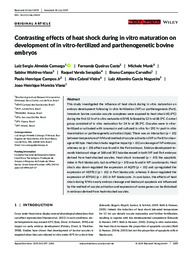Contrasting effects of heat shock during in vitro maturation on development of in vitro-fertilized and parthenogenetic bovine embryos.
Contrasting effects of heat shock during in vitro maturation on development of in vitro-fertilized and parthenogenetic bovine embryos.
Author(s): CAMARGO, L. S. A.; COSTA, F. Q.; MUNK, M.; WOHLRES-VIANA, S.; SERAPIÃO, R. V.; CARVALHO, B. C.; CAMPOS JÚNIOR, P. H.; VIEIRA, A. C.; NOGUEIRA, L. A. G.; VIANA, J. H. M.
Summary: This study investigated the influence of heat shock during in vitro maturation on embryo development following in vitro fertilization (IVF) or parthenogenesis (Part). Immature bovine cumulus?oocyte complexes were exposed to heat shock (41.0°C) during the first 12 hr of in vitro maturation (IVM), followed by 12 hr at 38.5°C. Control group consisted of in vitro maturation for 24 hr at 38.5°C. Oocytes were in vitro‐fertilized or activated with ionomycin and cultured in vitro for 192 hr post‐in vitro insemination or parthenogenetic activation (hpia). There was an interaction (p < .01) between temperature of IVM and method of oocyte activation (IVF or Part) for cleav‐age at 48 hpia. Heat shock had a negative impact (p < .01) on cleavage of IVF embryos, whereas no (p > .05) effect was found in the Part embryos. Embryo development towards blastocyst stage at 168 and 192 hpia decreased in both IVF and Part embryos derived from heat‐shocked oocytes. Heat shock increased (p < .05) the apoptotic index in Part blastocysts, but no effect (p > .05) was found in IVF counterparts. Heat shock also down‐regulated the expression of AQP3 (p < .01) and up‐regulated the expression of HSP70.1 (p < .01) in Part blastocysts, whereas it down‐regulated the expression of ATP1A1 (p < .05) in IVF blastocysts. In conclusion, the effects of heat shock during IVM on early embryo cleavage and blastocyst apoptosis are influenced by the method of oocyte activation and expression of some genes can be disturbed in embryos derived from heat‐shocked oocytes.
Publication year: 2019
Types of publication: Journal article
Unit: Embrapa Dairy Cattle
Observation
Some of Embrapa's publications are published as ePub files. To read them, use or download one of the following free software options to your computer or mobile device. Android: Google Play Books; IOS: iBooks; Windows and Linux: Calibre.
Access other publications
Access the Agricultural Research Database (BDPA) to consult Embrapa's full library collection and records.
Visit Embrapa Bookstore to purchase books and other publications sold by Embrapa.

